Introduction
This case study looks at the cultural influences that have informed the interior designs of Zaha Hadid from a Deconstructivism perspective.
Deconstructivism
Deconstructivism emerged in the 1980s as a new form of modern architecture to replace postmodern architecture. Deconstructivism adopted the ‘form follows fantasy’ concept, and in 1988, it came into the limelight when an exposition for ‘Deconstructive Architecture’ was organized with the philosophical concepts from Jacques Derrida, a French philosopher. It focused on buildings that were completely different from the traditional architecturally known buildings, but with no loss of utility while still adhering to primary laws of physics. These structures have exceptional curves, appear more abstract, and raise more questions about the role of art in architecture. Specifically, the buildings present the impression of fragmented objects, a lack of continuity, harmony, and/or symmetry. Apart from building fragmentation, Deconstructivism is known for manipulating features of the surface of the building and developing non-rectilinear shapes. These shapes create the impression of dislocated architectural elements. The final structure gives the visual appearance of unpredictability and well-managed chaos (see fig. 1). To this end, Deconstructivism is extremely different from postmodern practices.
Deconstructivist buildings appear as large abstract sculptures. As such, not many have been constructed because of high costs, unbuildable tags, and many organizations have not demonstrated a keen interest in such structures for their skyscrapers, even less because of their functional reality. Hence, only limited structures for governments and private clients have been executed successfully.

Dame Zaha Mohammad Hadid
Formative Years
Zaha Hadid (1950 – 31 March 2016) was an Iraqi-British architect and designer known for peculiarly neo-futuristic designs depicted by exceptional curving features noted in stretched-out structures accompanied with several viewpoints and split geometry to reflect chaos observed in contemporary life (Shahin).
Family and Cultural Influences
According to Hadid, her parents failed to distinguish between art and science. Brought up in Iraq, Hadid spent her childhood playing with mathematical problems just as much as with drawings, pencils, and brushes. Hadid further claimed that these experiences perhaps shaped her interest in architecture about abstraction, fragmentation, and explosion. She deconstructed ideas of uniformity and mass production by breaking the established rules and deviating away from all the practices of past architectural movements. Hadid pointed out that painting and sketching needed extremely high levels of precision and concentration, and they played a critical role in her career. These techniques provided an opportunity for extensive experimentation in both movement and form, providing novel ideas for designs.
Education Influences
Hadid grew up in Baghdad in a building inspired by Bauhaus in the era when modernism was viewed as an attractive and progressive movement in the Middle East (Søberg). She studied mathematics in Beirut and later moved to London to study architecture. Hadid had an opportunity to interact with notable figures like Rem Koolhaas, Bernard Tschumi, and Elia Zenghelis. Hadid proceeded to work for Zenghelis and Koolhaas in Rotterdam. In 1977, she was made a partner, and through her professional involvement with Koolhaas, Hadid met other renowned professionals, such as Peter Rice – they significantly impacted her career growth. In the 1980s, Hadid established her own practice in London and later taught at the Architectural Association. Hadid taught in several universities, including the University of Applied Arts Vienna in Austria and Harvard.
Recognitions
In this profession, Hadid received numerous awards, including the Pritzker Architecture Prize, 2004 (the first woman), the Stirling Prize (2010 and 2011). In 2012, Elizabeth II appreciated the works of Hadid in architecture and made her a Dame. She later received the Royal Gold Medal from the Royal Institute of British Architects in 2015 – the first woman to get such recognition.
According to an article done by The Guardian, Hadid was known as the queen of curves who transformed architectural geometry and instilled a novel expressive distinctiveness (Moore). Some of Hadid’s notable projects include the Aquatic Centre London, Broad Art Museum of Michigan State University, Zaha Hadid’s Heydar Aliyev Museum in Baku, and the Chinese Guangzhou Opera Centre. The posthumous designs include the AlWakrah Stadium in Qatar to host the 2022 FIFA World Cup.
Hadid presented some high-profile interior designs, such as the Mind Zone found at the London’s Millennium Dome, fluid furniture pieces, and the Z.C AR – the three-wheeled hydrogen-powered automobile. Hadid also worked with Lacoste to deliver a novel, high-end fashion, and sophisticated boots in 2009. Further, she worked with Triflow Concepts for exceptional two new designs with the parametric architectural style.
Hadid came from a wealthy and extremely liberal Iraqi family. Modernisation and Westernisation were a part of her upbringing, and progress defined their education and career. As such, Zaha’s early experiences instilled some unconventional practices, and her thoughts and behaviors were often seen as irrational or liberating. Hadid paid little attention to dogma.
Material Influences
Contemporary materials and design technologies generally impacted Hadid’s designs. For instance, she used colors (mainly black and white), glass fiber, glass, metal, water, wood, diamond, glossy lacquered stainless steel, stones, and marbles among others. Hadid used them to pioneer new works of art, drive an all-encompassing vision, and attain her ergonomic properties, fluidity, proportion, signature curves, angles, and multiple layouts. These materials transcend any culture. As such, Hadid was considered a designer well ahead of her time (Moore).
Cultural Influences in the Design World
Numerous factors impact the final product of a design process. These include the designer, users, developers, marketers, and others. That is, the design process is a function of all these contributing factors. Cultures always influence all aspects of human life, including the built environments. Hence, even past and contemporary buildings were not exempted from attributes of cultures (Razzaghi and Ramirez 2-9). Some known factors, such as physical appearance, material properties, structural strengths, and/or developmental challenges may affect the outcomes. The designer’s culture, values, emotions, a level of connectedness to the object, and aesthetic objectives among others, for instance, are unseen forces that also influence a design process. This implies that all designs are a reflection of both known and unknown forces managed to produce the desired results.
Contemporary cultures have further extended the boundaries while traditional cultures have persistently encouraged futuristic thinking approaches. Much progress has been attributed to traditional cultures relative to other known cultures, such as modern Western cultures.
Hadid’s Approaches to Interior Design
Moore noted that many past design projects by Hadid were considered unbuildable and, therefore, such projects were not widely discussed within academic and professional spheres. Nonetheless, built contemporary works by Hadid have attracted the attention of professionals, and here are a few cases for illustration.
Hadid’s ME Dubai Hotel captured some aspects of her interior design approach. For instance, the Hotel features a notable structural exoskeleton that curves upwards on the recessed glass facades to ensure that the floor plates are generally free from internal wall columns. She designed a lobby, event spaces, car parks, and restaurants, but the gill-like louvers that conceal parked cars stand out (Howarth). Further, the ground floor lobby is a reflection of Hadid’s recognized angled walls and curved surfaces (see fig. 2).

For this specific space, the designer introduced a “faceted metallic wall sculpture” (Howarth) that would go up to the ceiling on every side, and the metal was used to “reflect the water in the swimming pool” (Howarth) and to create a beacon that looked like a jewel below the roof equipped with a helipad.
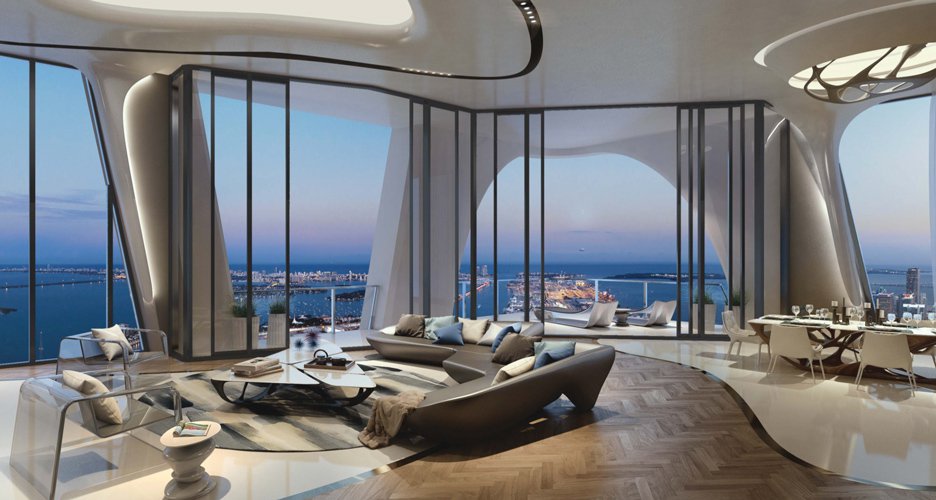
Hadid was responsible for designing the Michelin-star restaurants and bars of the ME Dubai Hotel that complemented the available space. She added a single metallic element that ran at one side to the nearby atrium next to the reception and branched it out to establish different balconies for every floor, moving on to the lower areas to offer seating space and areas for a café (see fig. 4).
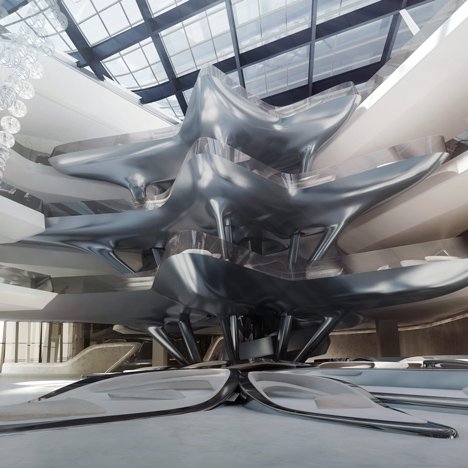
Hadid’s signature curvaceous style dominates the interior design. It is observed in all guest rooms with sculptural walls, fluid surfaces, and angular beds (see fig. 3). There is also a huge artwork created by glass spheres suspended below the glazed roof of the atrium. It is fitted with crest structures with steps that lead to the water, resulting in swooping shapes all over the edge of the pool and a minor asymmetric bridge curving across the water to connect the two ends.
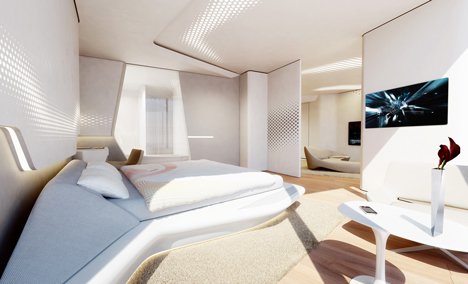
The tower’s hotel suites are designed to account for both residents and international visitors. On the other hand, nearby apartments under the scheme introduce an urban lifestyle and simultaneously offer a home-away-from-home experience with a panoramic view of the city. Every room is fitted with an interactive media center, an integrated digital environment supported with pivoting and sliding panels that control the volumes and are well lit with natural light (see fig. 5 and 6).
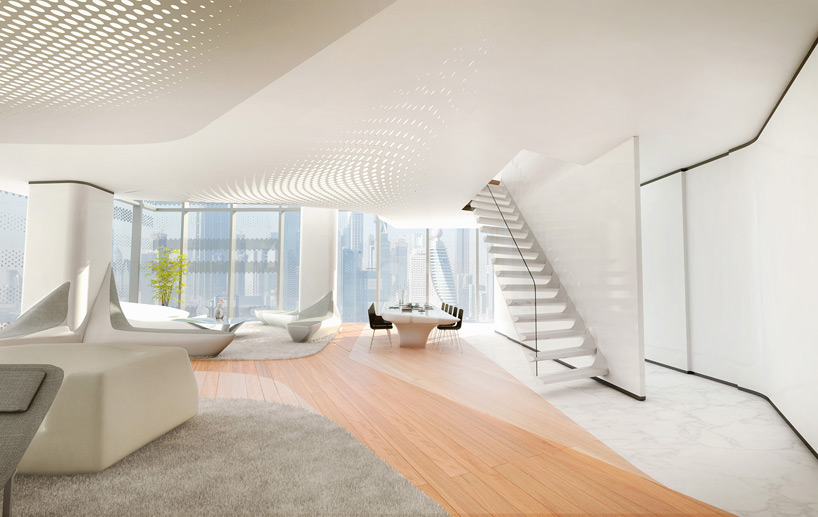
In the design, Hadid managed to present well-defined public spaces to ensure that people from various cultures, backgrounds, and nationalities could congregate and share their experiences. Notably, every piece of furniture in the rooms was either chosen or designed by Hadid, and the open plan living areas reflected the designer’s signature style.
Hadid’s interior designs are also noted in furniture. Nonetheless, they have transcended any cultures and embraced futuristic models and technologies. For the Cassina contract, Hadid focused on producing a novel sofa sculpture known as the Zephyr (see fig. 7). As previously noted, culture is everywhere, and in this case, Hadid gained inspiration for the futuristic shape from the eroded rock formations and sculpted in lacquered fiberglass using modern technologies for art and design production. This design brought about a new sofa concept because of its dynamic formation with whole new parts engraved from the solid base. The extremely crafted backrests and the twisting forms ensure that the sofa may be arranged in different many ways. The sofa was regarded as an iconic piece of design and a perfect representation of Hadid’s innovative approaches to design and experimentation. In this case, Hadid escaped the perceived cultural and traditional thinking constraints that limit design creativity. Hadid derived patterns, ideas, and concepts from graphics, arts, and paintings to rework and reinvent completely new designs.
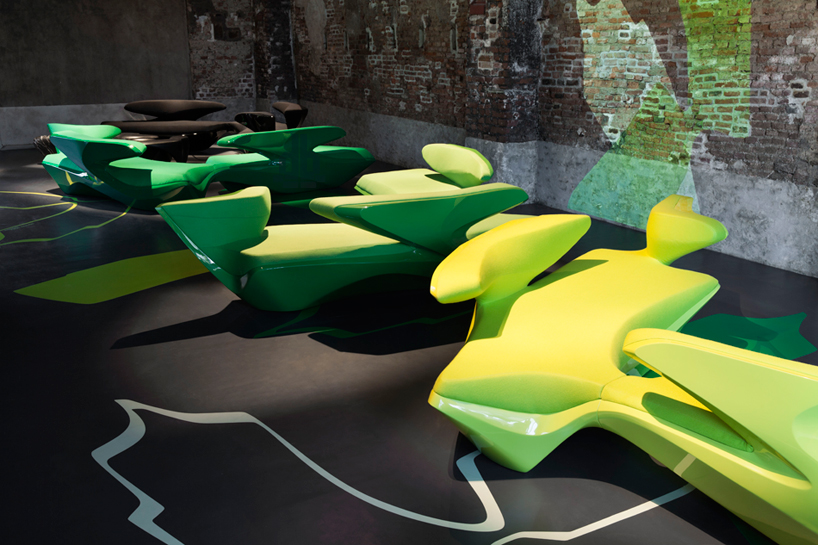
The sofa was a challenge for the design and production departments. It captures the best-in-class knowledge and experience in adhering to demanding technological requirements and relying on long-established standards of design excellence. The sofa required a thoroughly managed development process – the prototype, engineering, and production processes to carve the fiberglass into intricate geometries of Hadid’s signature design. Additionally, the finishing stage also needed a high degree of precision. Hadid ensured uniformly lacquered finishing of the sofa design to bolster its shape and the unique patterns of the cushion, which further reinforced complexity in the design.
Hadid adopted technologies early on, and she could take designs that were more challenging and defied traditional methods of design and architecture. Alongside Patrik Schumacher, she methodically strived for the possible parametric design, ensuring the conception and production of designs as seamless works. Moreover, Hadid continuously experimented with new fabrication methods to create new products. Some of the materials Hadid experimented with included wood, aluminum, diamond, and polyurethane among others. In 2011, she advanced modern architecture and design by exploring other aspects of fluid geometries, cutting-edge methods, and production technologies (Ashaboglu and Busta).
For the High Line Residential – 520 West 28th, the interiors have been furnished with dynamic white and minimal tones of the palette. The contemporary pieces of art and furniture fill the space. These choices were aimed at reinforcing the identity and voice of Hadid while advancing seamless indoor and outdoor living. The finishing displays minimalistic functionality, creating a layout for different clients, including couples or single dwellers. Pieces of furniture were selected to exploit the natural light realized through the installed large windows (Lynch).
Hadid’s Contemporary Approaches
A Global Focus
Hadid was internationally recognized for her many points of view and fragmented geometric designs. She completed many ambitious projects involving aspects of cultures that spread across the world. Hadid’s works can now be found in major cities, including Rome, Abu Dhabi, Baku, Beijing, and London among others. Together with her exceptional conceptual and historical experiences, Hadid captured aspects of the art movement traced back to over a century and the impacts of Malevich’s avant-garde art. She also drew from nature, other cultures, and her own wide experiences from various parts of the world. Hadid went further and pushed beyond regular creative works and artistic limits. Her works remain bold and influential for many years to come.
To Koolhaas, Hadid was “a planet in her own inimitable orbit” (Moore), implying that Hadid had her own thoughts on design and architecture to nurture, which eventually led to her own style of Deconstructivism and a new form of neo-modernism design and architecture. Hadid borrowed from both constructivism and suprematism.
It is difficult to peg Hadid’s work with a specific culture. Instead, her architecture was perhaps influenced by different cultures but always strived to create new forms that transformed to give new meanings to space. They involved limited theories and could not expressly state what a specific shape meant. More importantly, Hadid did not strive for her own cultural identity in her works.
Strikingly, and unusually tactfully, Hadid did not discuss issues affecting Iraq. Rather, she wanted her works to lend their own meaning and speak for themselves. However, this never meant that they were simply designs in architectural form. For instance, Hadid’s fascination with shadow and ambiguity is profoundly entrenched in Islamic architectural tradition. Additionally, her fluid, open approach is a politically charged response to more and more fortified and unjust modern urban landscapes. On this note, Hadid’s built structures are today among the most undoubtedly influential considering the superiority of architecture in the development of space. One can observe that what Hadid had attained with her unmatched manipulation of ground planes, walls, and roofs alongside other open, interwoven, transparent, and fluid spaces, are clear evidence that architecture, as a fine form of art, can continuously be improved upon and is never restricted with imagination or cultures.
Today, interior designers have observed that global clients are increasingly taking over the property markets. More importantly, every nationality has a specific culture that shapes their preferences and lifestyles. As such, designers like Hadid strive to understand the cultures of their clients and to develop suitable buildings for them. While most rich clients may share some aspects of taste, individual preferences of clients are equally important to designers. Individuals who wish to purchase buildings often have certain, intricate wishes.
Futuristic Views
Hadid, based on her upbringing, had been thoroughly preoccupied with transforming the common notions about space from physical, social, and cultural perspectives. This implies that no single culture can be used to define her product designs. Strikingly, Hadid’s designs are renowned for their dynamic formal features of curved shapes, fluid, or crystallized strata. All these capture a new form of Baroque, esthetic, more vibrant, and involving a form of architecture.
Hadid’s fragmented futuristic designs are identified by zoomorphic and pointed cantilevers. According to some of her detractors, Hadid’s works were oppressive and arrogant, and that the designs gobbled energy and did not embrace their environments. That is, they were not ‘nice’, and Hadid personally wanted her designs to be raw, dynamic, and to reflect some earthy features. The designer believed in testing boundaries, going further, showing the determination for innovation, the passion, the irrelevance of practical constraints, and the rejection of conventional practices and society. Hadid used her personality and talent to earn victory and fame. In other words, her designs were not bound by specific cultures. To her senior partner, Patrik Schumacher, Hadid’s designs reflected a novel form of space that strived for the new, previously unthinkable territory of constructive freedom (Moore).
Criticism
Moore observed that not everyone shared the same sentiments for Hadid. According to Bayley, Hadid was known as an architect who never built anything for almost 14 years. Further, critics argued that Hadid had not embraced locality or context, preferring to advertise herself as a ‘global architect’ using expensive, difficult-to-build designs rather than serve clients’ needs and build functional structures (Bayley).
In South Korea, Seoul’s Dongdaemun Design Plaza is discussed under failed architecture because critics assert that the building lacks any rationale in design, large empty spaces, irregularly shaped pavilions, and it is associated with severe social and financial impacts (Boer).
The Beijing Cultural Heritage Protection Centre expressed its shock when the Galaxy Soho consisting of shops and offices was awarded the RIBA award. While the RIBA recognized Hadid’s visionary novel thinking regarding contemporary urban challenges, the Beijing heritage center considered it as one important cause of the destruction of the town’s culture. Further, the Baku project also attracted criticism. Detractors argued that it was commissioned to elevate a government notorious for massive human rights violations, as well as forced evictions of property owners to make way for the structure. Such criticisms extend to Libya, Iraq, Russia, Qatar, and China (Bayley). Here, others, such as Rem Koolhaas and Lord Foster have also been accused of similar deeds after working with oppressive regimes of China and Kazakhstan.
Nonetheless, to Hadid, cultural constraints are minimal and functional optimality is not preferred. Instead, she favored experimental improvement of social practices of possibly elevated functionality. In other words, designers must strive for excellence for a better world in the future through experimentation, and Hadid perfected that approach.
Conclusion
Hadid’s designs were exceptionally unique with minimal Islamic or specific cultural influences. She strived to deviate from the norm through strong conceptual designs. Instead, she designed projects of all kinds of functional values. The designs were fragmented and fluid to reflect Deconstructivism and more assertive to show that indeed a different, better future world is possible. Through experimentation with new technologies, ideas, and materials, Hadid managed to create projects across different cities globally.
Transcending beyond cultural and other forms of constraints, many have claimed that Hadid was an architect and a designer ahead of her time and managed to conquer a white-male-dominated field as she strived to respond to emerging social issues in urban settings. She ultimately earned the reputation as the queen of curves in her design while aiming to transform the general concept of space as defined socially, culturally, and physically. Hadid’s works, therefore, were difficult to define with any specific cultures.
Works Cited
Ashaboglu, Selin, and Hallie Busta. “The Product Design of Zaha Hadid.” Architect Magazine. 2016. Web.
Bayley, Stephen. “The Heckler: Architecture Would Be Better Off without Zaha Hadid.” The Spectator. 2015. Web.
Boer, René. “On Zaha Hadid’s Dongdaemun Design Plaza.” Failed Architecture. 2016. Web.
Chin, Andrea. “Zaha Hadid: Zephyr Sofa for Cassina.” Design Boom. 2013. Web.
Howarth, Dan. “Zaha Hadid’s Interiors for One Thousand Museum Tower in Miami Revealed in New Images.” Dezeen, 2016. Web.
Lynch, Patrick. “Interiors of Zaha Hadid’s Nearly-Complete High Line Residential Building Revealed.” Arch Daily, 2017. Web.
Moore, Rowan. “Zaha Hadid: Queen of the Curve.” The Guardian, 2013. Web.
Razzaghi, Mohammad, and Mariano Ramirez. The Influence of the Designers’ Own Culture on the Design Aspects of Products: Framework. n.d. Web.
Shahin, Assia. “The Buildings of Zaha Hadid, Queen of Curves.” The Italian Eye Magazine, 2016. Web.
Søberg, Martin. “Zaha Hadid Architects.” Arc Space. Web.